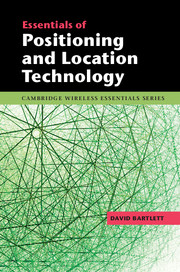Book contents
- Frontmatter
- Contents
- Miscellaneous Frontmatter
- 1 Introduction
- 2 Coordinate systems
- 3 Satellite positioning (GNSS)
- 4 Radiolocation technologies
- 5 Inertial navigation
- 6 Other techniques and hybrid systems
- 7 Techniques and performance
- 8 When things go wrong
- 9 Location-based services and applications
- 10 A brief look at the future
- References
- Index
4 - Radiolocation technologies
Published online by Cambridge University Press: 05 April 2013
- Frontmatter
- Contents
- Miscellaneous Frontmatter
- 1 Introduction
- 2 Coordinate systems
- 3 Satellite positioning (GNSS)
- 4 Radiolocation technologies
- 5 Inertial navigation
- 6 Other techniques and hybrid systems
- 7 Techniques and performance
- 8 When things go wrong
- 9 Location-based services and applications
- 10 A brief look at the future
- References
- Index
Summary
There are several techniques for using radio signals to determine the position of an object:
Angle of arrival of a received signal indicates the direction to the transmitter. On its own this does not allow position to be determined as one also needs to know the distance between transmitter and receiver.
Direct inference of range. Range can be inferred in a number of ways: using signal strength; using techniques for measuring the time-of-flight of the radio signal; using phase of the received signal as a measure of range (assuming techniques for synchronising transmit and receive clocks can be implemented).
Measuring the time of arrival of a radio signal. In the absence of a definitive time reference (usually the case) it is necessary to measure arrival times of two or more signals and then by comparing them a position can be computed. Time Difference of Arrival or Observed Time Difference of Arrival is the most common way of resolving clock uncertainties.
This chapter will look at each of the main techniques in turn, identifying their strengths, weaknesses, advantages and disadvantages, with an emphasis on their practical use in real-world positioning systems.
Angle of arrival
Measuring the angle of arrival (AOA) of a radio signal is one of the oldest methods of locating a source and for many applications is still the preferred method. Radar systems are based on the principle of angle or bearing to target; they make use of a highly directional antenna sweeping the area and looking for echoes from reflective objects in the scanned area. Homing or beacon finding devices, often used for tracking wild animals or for stolen car recovery, may use angle of arrival to locate the source, a radio transmitter attached to the object being tracked, and then follow the direction of the radio signal until the quarry has been found. Most optical systems for tracking a target, whether with moving or fixed cameras are based on measuring the angle to the target.
Information
- Type
- Chapter
- Information
- Essentials of Positioning and Location Technology , pp. 59 - 87Publisher: Cambridge University PressPrint publication year: 2013
Accessibility standard: Unknown
Why this information is here
This section outlines the accessibility features of this content - including support for screen readers, full keyboard navigation and high-contrast display options. This may not be relevant for you.Accessibility Information
- 1
- Cited by
